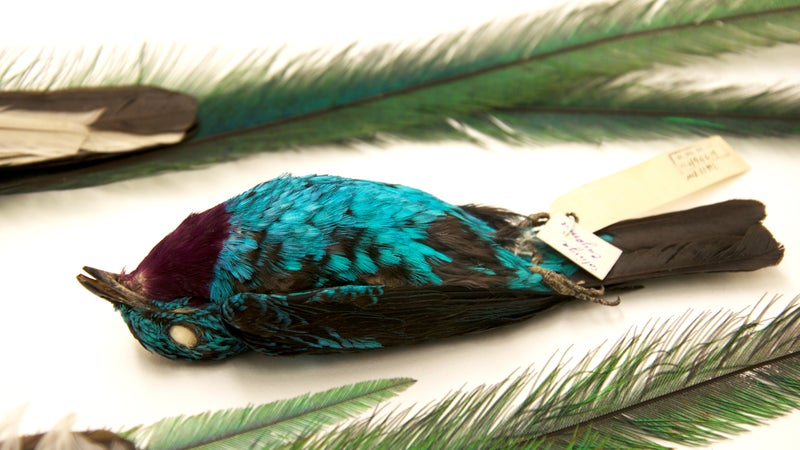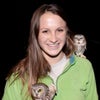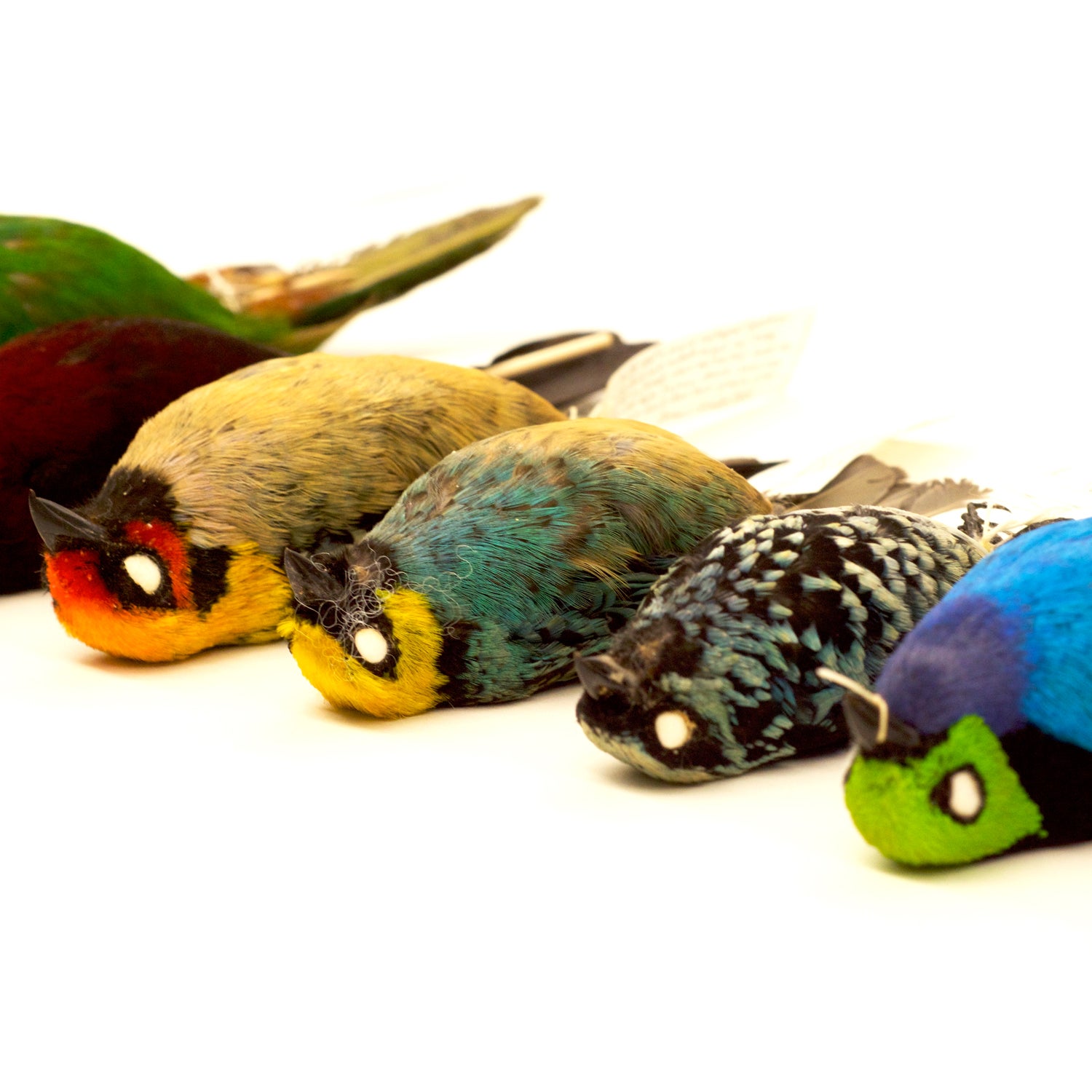A few years ago, before I began a Ph.D. in ornithology, I studied nomadic parakeets in Ecuador. I planned to track them with GPS devices, but I didn’t know the birds’��exact weight. Weight might seem like a trivial detail, but it’s incredibly important when you need to put a small GPS tracker on one. Existing literature didn’t help much. Luckily, I found my answer at the in Quito, home to two specimens of the Golden-plumed parakeet. As I turned them over in my hands and read through their specimen labels, I was surprised to learn that both were collected near my study site, in the early nineties. The female weighed 22 grams more than I expected, and the male 32 grams more. Suddenly��I had more options for heavier tracking devices, opening up new possibilities for my research.��
Since then, I’ve lost count of how many times, and in how many ways, museum��collections��have proven invaluable to me. Natural history museums are often described as “libraries of life,” and each specimen, also known as a��voucher or study skin,��is an��indispensable��piece of the biological record. The more complete the library, the more we can hope to understand and protect.��
In (Viking,��$27), Kirk Wallace Johnson tells the true story of Edwin Rist, a��man who is wholly unaware of the value of scientific collections. The book opens in 2009 with Rist, a gifted��student the Royal College of Music, robbing London’s famous Tring��Natural History��Museum��in the dead of night. He hops a wall, breaks in through a window, and wheels a suitcase down a dark hallway to cases of historic bird specimens, some of which were collected by Darwin’s contemporary, . Rist targets some of the world’s rarest and flashiest birds; the “blue chatterer”��(), “Indian crow”��(), , and . He steals 299 precious skins that he sells to finance a new gold flute. The judge who oversaw the case called the heist a “natural history disaster of world proportions.”��
To many, the crime is absurd: Why steal dead birds? The answer is that Rist has a passion greater than music; he is a world-renowned salmon flytier, trained in the classic Victorian practice��and resolute in his desire to revive the antiquated art. In Victorian days, fly-tying��manuals detailed intricate “” for catching salmon that called for the dazzling feathers of rare and endangered birds. But after the Victorian feather craze died down��and stricter laws passed, including the (CITES) and the , rare feathers became increasingly hard to procure. Yet, in the underground world of fly-tying, the art lives on. Zealous��flytiers and obsessed hobbyists go to incredible lengths—searching online fly-tying forums, scouring eBay, paying exorbitant amounts—to obtain the iridescent and brightly colored feathers of exotic birds.��

Rist once for legendary hookmaker Ronn Lucas’s website, “Fly-tying is not merely a hobby, it is an obsession we seem to devote a substantial part of our time to…, examining feather structure, designing flies, and coming up with new techniques for getting exactly what we want out of a fly.”��
Wallace Johnson gives a detailed and accessible overview of the many worlds that collide in Rist’s theft: he describes Victorian “feather fever,” the quirky history of fly-tying and flytiers, early British ornithological collections, and Alfred Russel Wallace’s invaluable contributions to science through his journeys to South America and the Malay Archipelago. Understanding the lengths that early explorers went to obtain each specimen makes the theft feel even more visceral: Alfred Russel Wallace endured food rationing, swollen ankles, and disease to acquire each specimen. He once defended his painstaking efforts, describing each species as “the individual letters which go to make up one of the volumes of our earth’s history; and, as a few lost letters make a sentence unintelligible, so the extinction of numerous forms of life which the progress of cultivation invariably entails will necessarily render obscure this valuable record of the past.”��
After Rist’s successful heist, he brings��the stolen birds back to his apartment, where he plucks the most colorful feathers from each study skin and cuts parts of each bird into small pieces for illegal online sales. As I read this, my stomach knotted in pain. Each bird��had been studied by scientists for decades, a priceless time stamp in the biological record; yet, when Rist finished with them, he tossed each skin into a cardboard box by his closet. More heartbreaking��still��was that he cut many of the tags off the��specimens, rendering them effectively useless without their locality, date, and identifying information.��
It’s hard to overstate the tragedy of destroying irreplaceable scientific objects. Natural-history collections are vital to our understanding of biodiversity, evolution, and environmental change, and they only grow more valuable with time. In the late 1960s, museums were critical to��between the pesticide DDT and eggshell thinning. This research convinced the U.S. government to ban DDT to protect declining populations of birds of prey. Last year��biologists used more than 1,300 bird skins to produce a in the U.S. manufacturing belt from the early��to mid 20th��century, filling a large gap in the historical record. At my own institution—the , which houses over four��million vouchered specimens from around the world—researchers used historic vouchers��to as the reservoir for the deadly hantavirus, and they confirmed the virus’s presence in populations nearly 15 years prior to the 1993 outbreak.��It was only because deer mice had been archived in the museum dating back to 1979 that scientists were able to answer questions over one decade later that no one imagined would need answering, underscoring the importance of scientific collections.��
At the Museum of Southwestern Biology, our collection includes extinct species like the and , type specimens (the original specimen upon which a new species name and description is based), and rarities��that are hard to find anywhere else. The collection plays an integral role in courses; public outreach; and our team’s research on the evolutionary adaptations of birds to high-altitude environments, and how bird ranges might be affected by climate change. It’s impossible to predict what questions about environmental change, population genetics, or evolution we may want to ask 20 years from now; specimens provide important historic baselines, and new technologies will only increase the breadth of questions we can address using these samples, a point by leading scientists.��
One of Rist’s most tragic admissions is that he doesn’t understand why the Tring (or any museum) needs “so many” of each study skin; he admits he thinks they’re useless if they just sit in drawers. Similarly, one might ask: Why does a library need so many books? But��unlike a book, each specimen represents a singular, unique record in time. A King Bird-of-paradise collected by Alfred Russel Wallace in 1858 has a much different value than one collected in 2018, because the information we can glean about genetics, evolution, and ecology corresponds to time and place. By robbing the Tring of something that can never be restored, Rist did truly irreparable damage to the biological record.��
Wallace Johnson succeeds in conveying the gravity of this natural-history “heist of the century,” and one of The Feather Thief’s greatest strengths is the excitement, horror, and amazement it evokes. It’s nonfiction that reads like fiction, with plenty of surprising moments beyond the crime and its aftermath. Wallace Johnson’s writing style is honest and reflective at times. In one nod to forgotten history, he emphasizes the critical role that early feminists played in bringing an end to feather fever: “In an era when women were expected to remain at home and had yet to be granted the right to vote or own property, the abolition of the feather trade was ultimately their work.”
The Feather Thief is a compelling blend of mystery, quirky salmon flytiers, and dogged natural-history enthusiasts, and it highlights the obsessive lengths that people will go to destroy—and protect—some of the world’s most valuable treasures. The book’s main drawback is that the suspenseful tone and diligent quest for answers isn’t matched by the rather abrupt ending, acknowledging that��the underground fly-tying world and illegal feather sales are still��flourishing.��Then again, perhaps the unfinished feeling is justified: How do you conclude a real-life mystery when many stolen specimens haven’t yet been recovered, and likely never will be?


